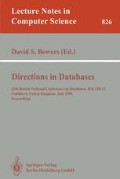Abstract
This paper introduces a new approach to incorporating the temporal dimension in database systems. Instead of introducing time as an attribute in a conventional state database the paper proposes that state databases are derivatives from event databases which are regarded as fundamental. A data modelling approach is introduced together with a realization in terms of a Temporal Functional Database Language (TFDL).
Preview
Unable to display preview. Download preview PDF.
References
J. Ben-Zvi. The Time Relational Model. PhD. thesis, computer Science department, UCLA, 1982.
P. Buneman, R.E. Frankel and R. Nikhil. An implementation technique for database query languages. ACM Trans. on Database Systems, 7(2): 164–186, June 1982.
R.M. Burstall, D. B. McQueen and D. T. Sannella. HOPE: An experimental applicative language, Edinburgh University Research Report CSR-62-80.
J. Clifford and D.S. Warren. Formal semantics for time in databases. ACM Transactions on Database Systems, 8(2):214–254, June 1983.
J. Clifford and A. Croker. The historical relational model (HRDM) and algebra based on lifespans. In Proceedings of the Third International Conference on data Engineering, 528–537, Los Angeles, CA, February 1987.
S.K. Gadia. A homogeneous relational model and query languages for temporal databases. ACM Transactions on Database Systems, 13(4):418–448, December 1988.
J.R. Hindley and J.P. Seldin. Introduction to combinators and the lambda calculus. Cambridge University Press 1986.
P.J.H. King and A. Poulovassilis. FDL: A language which integrates database and functional programming. Actes du Congres INFORSID 88, pp. 167–181, La Rochelle (1988).
K.G. Kulkani and M.P. Atkinson. EFDM: Extended Functional Data Model, Computer Journal, 29:38–46, Jan 1986.
Lorentzos N.A. DBMS support for time and totally ordered compound data types. Information systems Vol 17, No 5, pp. 347–358
N.A. Lorentzos and R.G. Johnson. Extending relational algebra to manipulate temporal data. Information Systems,13(3):289–296, 1988.
S.B. Navathe and R. Ahmed. A temporal relational model and a query language. Information Sciences, 49(2): 147–175, 1989.
A. Poulovassilis. The Implementation of FDL, a Functional Database Language. The Computer Journal, 35(2): 119–128, 1992. C.U.P.
A. Poulovassilis. A pattern-matching algorithm for functional databases. The Computer Journal, 36(2): 195–199, 1993.
A. Poulovassilis and P.J.H. King. Extending the functional data model to computational completeness. Advances in Database Technology (EDBT 90), lecture Notes in Computer science, No 416, Springer-Verlag, 1990.
N.L Sarda. Extensions to SQL for historical databases. IEEE Transactions on knowledge and data Engineering, 2(2):220–230, July 1990.
D.W. Shipman. The functional data model and the data language DAPLEX. ACM Trans. on Database Systems, 6:140–173, March 1981.
R. Snodgrass. The temporal query language TQuel. ACM Transactions on database systems, 12(2):247–298, July 1987.
R. Snodgrass and I. Ahn. A taxonomy of time in databases. SIGMOD 1985, pp 236–246
D.R. Sutton and P.J.H. King. Integration of modal logic and the functional model. BNCOD 10, Lectures Notes in Computer Science, 156–174, Springer-Verlag 1992.
A.U. Tansel. A historical query language. Information Sciences, 53:101–133, 1991.
A.U. Tansel, J. Clifford, S. Gadia, S. Jajodia, A. Segev and R. Snodgrass. Temporal Databases theory, design, and implementation. Chapter 20: 496–533, Benjamin/Cummings 1993.
D.A Turner. Miranda: A non-strict functional language with polymorphic types. Lecture Notes in Computer Sciense, Vol 201, Springer-Verlag 1985.
J.J.V.R. Wintraecken. The NIAM Information Analysis Method: Theory and Practice. Kluwer, Deventer, The Netherlands, 1990.
Author information
Authors and Affiliations
Editor information
Rights and permissions
Copyright information
© 1994 Springer-Verlag Berlin Heidelberg
About this paper
Cite this paper
Soukeras, S., King, P.J.H. (1994). Temporal databases: an event oriented approach. In: Bowers, D.S. (eds) Directions in Databases. BNCOD 1994. Lecture Notes in Computer Science, vol 826. Springer, Berlin, Heidelberg. https://doi.org/10.1007/3-540-58235-5_34
Download citation
DOI: https://doi.org/10.1007/3-540-58235-5_34
Published:
Publisher Name: Springer, Berlin, Heidelberg
Print ISBN: 978-3-540-58235-9
Online ISBN: 978-3-540-48580-3
eBook Packages: Springer Book Archive

